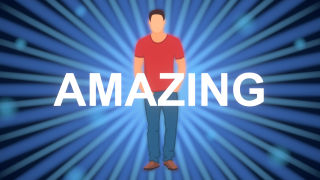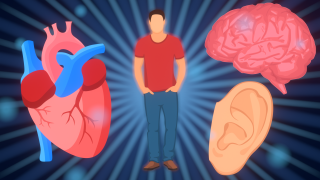You're Amazing
Published: June 14, 2025 at 9:40 PM (PT)
7:24
(13347 frames/30fps) Resolution:3840x2160
(4K/UHD) Most Rewatched:N/A Realtime Statistics...
30 Minutes...
Hour...
24 Hours...
Information Sources
https://journals.plos.org/plosone/article?id=10.1371/journal.pone.0006256
Human's Biophoton Emissionhttps://www.sciencealert.com/you-can-t-see-it-but-humans-actually-glow-in-visible-light
Strength of Human Femurhttps://www.guinnessworldrecords.com/world-records/420635-strongest-human-bone
Average Weight of a Humanhttps://en.wikipedia.org/wiki/Human_body_weight
Average Vehicle Weightshttps://www.epa.gov/system/files/documents/2022-12/420r22029.pdf
Weight of a Semi-Truckhttps://schneiderjobs.com/blog/how-much-does-a-semi-truck-weigh
Hyoid Bonehttps://my.clevelandclinic.org/health/body/hyoid-bone
How Fast Blood Circulates the Bodyhttps://atlanticcardiovascular.com/blog/how-long-does-it-take-for-blood-to-circulate
Heart Factshttps://www.pbs.org/wgbh/nova/heart/heartfacts.html
Average Human Lifespanhttps://www.worldometers.info/demographics/life-expectancy
You Can Hear While Unconscioushttps://pubmed.ncbi.nlm.nih.gov/36413639
Synaptic Firing Rate of the Human Brainhttps://www.neuwritewest.org/blog/4541
REM Sleephttps://www.sleepfoundation.org/stages-of-sleep/rem-sleep
Energy Use of the Human Brainhttps://pmc.ncbi.nlm.nih.gov/articles/PMC8364152
Energy Use of a LaptopReal-world measurement of 8W minimum when idle, 15W minimum when working, 100W+ when doing heavy work
Cells in the Human Bodyhttps://pmc.ncbi.nlm.nih.gov/articles/PMC4991899
Cells Which Don't Contain DNAhttps://www.wtamu.edu/~cbaird/sq/2013/08/22/why-does-every-cell-in-our-body-contain-dna
Length of DNA in a Human Cellhttps://www.ncbi.nlm.nih.gov/books/NBK26834
8 Planets Factsheethttps://blendertimer.com/factsheets/solar-system/planet-factsheet
Base pairs in a Bacteriahttps://www.sciencedirect.com/topics/neuroscience/bacterial-dna
Length of a Base Pairhttps://en.wikipedia.org/wiki/Base_pair
Milky Wayhttps://en.wikipedia.org/wiki/Milky_Way
Amount of DNA on Earthhttps://pmc.ncbi.nlm.nih.gov/articles/PMC4466264
Graphic Sources
https://pixabay.com/vectors/person-man-stand-human-arms-legs-8238232
Human Skeleton-Front (Daniel Roberts)N/A
Steel Pipe (Daniel Roberts)N/A
Bone (Daniel Roberts)https://pixabay.com/vectors/bone-skeleton-anatomy-cutout-9079454
Human Femur (Daniel Roberts)N/A
Yellow Car (Daniel Roberts)https://www.alamy.com/just-an-orange-car-image471694088.html
Semi-Truck (Daniel Roberts)https://pixabay.com/vectors/semi-truck-truck-semi-trailer-9089823
Hyoid Bone (Daniel Roberts)N/A
Human Heart (Daniel Roberts)https://pixabay.com/vectors/heart-anatomy-human-organ-veins-7735546
Space Shuttle (Daniel Roberts)https://pixabay.com/vectors/space-shuttle-rocket-challenger-8297058
Earth (Daniel Roberts)https://pixabay.com/vectors/earth-planet-space-terrestrial-8233221
The Sun (Daniel Roberts)https://pixabay.com/vectors/sun-star-space-solar-light-bright-8328084
Ear (Daniel Roberts)N/A
Human Brain (Daniel Roberts)https://pixabay.com/vectors/brain-human-anatomy-organ-body-7822205
Laptop (Daniel Roberts)https://pixabay.com/vectors/laptop-computer-technology-business-7884573
Red Blood Cell (Daniel Roberts)https://pixabay.com/vectors/blood-cell-red-human-anatomy-8307724
Cell (Daniel Roberts)N/A
The Milky Way (Daniel Roberts)https://pixabay.com/vectors/milky-way-galaxy-abstract-space-8282020
Thyme (Daniel Roberts)N/A
SMPTE Color Bars (Daniel Roberts)https://pixabay.com/vectors/smpte-color-bars-cctv-colorful-bars-5791787
Observable Universe (Daniel Roberts)N/A
Audio Sources
N/A
To the Galaxy (Daniel Roberts)https://pixabay.com/music/ambient-to-the-galaxy-10734
Dwindling Hope (Daniel Roberts)https://pixabay.com/music/ambient-dwindling-hope-287000
Beyond the Abyss (Daniel Roberts)https://pixabay.com/music/ambient-beyond-the-abyss-2-58-336507
Hit-02 (Daniel Roberts)N/A
Beyond Infinity (Daniel Roberts)https://pixabay.com/music/pulses-beyond-infinity-159345
Rescuer-Inspiring Cinematic (Daniel Roberts)https://pixabay.com/music/main-title-rescuer-inspiring-cinematic-229615
Chapters
You glow in the dark
0:37Your bones are strong
2:20Your heart is SUPER resilient
3:36Your always listening
4:04Your brain is amazing
5:12You have a TON of DNA
You are amazing. You literally glow.
No seriously, humans glow in the dark.
Just barely. We only emit a very
small amount of light. Such a
tiny amount that only specialized
equipment can actually see it.
The brightness of the light is
about a thousand times dimmer
than what humans can perceive.
This glow is known as biophoton
emission, which is slightly different
from bioluminescence. The reason
we produce the light is something
related to our metabolism and
highly reactive free radicals
interacting with free-floating
lipids and proteins and a whole
lot of other stuff that I'm not
about to try and explain.
Also...you're tough...kinda.
Your skeleton is made of bones
(who knew) and those bones are
stronger than steel! Well...kind of...
Bones are stronger than steel
by weight, so a regular bone isn't
going to be stronger than a steel
bone since the steel is way more
dense and thus weighs a lot more
and is thus much stronger. But
if you made a steel bone using
a small enough amount of steel
that it weighed the same as a
regular bone, the regular bone
would be stronger than the steel bone.
Your femur (also known as the
thighbone) is more special than
most of your bones. It's not only
the largest bone in your body
but also the thickest and strongest.
It holds a lot of weight and often
has a lot of force applied to
it (such as when you're walking
or running) so it had to be created
incredibly strong. But it's probably
far stronger than you'd expect.
The femur is so strong that it
can support about 30 times your
body weight! That means just one
femur from an average person weighing
62 kilograms could support nearly
2 tonnes, about the weight of
an average car! And if you weighed
more, such as 100 kilograms, 4
of your femurs would be able to
support an entire semi-truck!
Well, an empty one at least and
also ignoring the fact that most
humans don't have four legs. But
that's still absolutely amazing!
Oh, and another special bone
is the hyoid bone. The hyoid bone
is the only bone in the human
body which is not directly connected
to another bone. It's important
for really minor things like um...
speaking and swallowing.
Anyway, something else, besides
your bones, that makes you tough
is your heart. It doesn't really
matter how soft-hearted you are,
you have an incredibly tough
or rather resilient heart. Your
heart, despite all its intricate
and seemingly fragile mechanisms,
has been working non-stop for
your entire life. No rests, no
stops for repair, just continuously
pumping blood and keeping you alive.
At least for most of us.
Your heart pumps blood through
your blood vessels at up to 40
centimeters per second, the blood
completing 1 entire circuit of
your body in about 20 seconds!
In those 20 seconds it pumps around
5 liters of blood a total of 4
kilometers. That means in the
average lifetime of 70 years the
heart pumps around 600 million
liters of blood, which is about
this much. The total distance
the blood was pumped would be
around 500 million kilometers,
about the distance around the
Earth 12 thousand times or 3 times
the distance from Earth to the Sun.
500 million kilometers, 600 million
liters of blood, 2.5 billion beats,
and absolutely no breaks for rest.
I'm getting tired just thinking
about it.
But you want to know something
else that never stops? Your ears.
You are constantly hearing the
sounds around you. Even while
you're sleeping or even while
you're unconscious, you are constantly
hearing sounds. It's just that
sometimes your brain chooses to
ignore the sound or fails to process
the sound. For example, you may
have been woken up before because
of a loud noise. In order for
you to hear that noise, you had
to be listening.
Which, speaking of sleeping,
your brain is very active with
all your neurons firing billions
or trillions of times per second.
But what's crazy about this is
that your brain can sometimes
become more active while you're
sleeping, exceeding the activity
levels of the brain when you're awake.
And there's something else fascinating
about your brain. Well, there
are a lot of fascinating things
about your brain, but just one
of those things is that your brain
uses only about 20 watts of electricity.
That is incredibly power efficient!
For comparison, even a very basic
laptop will generally use around
20 watts while doing basic work
and more powerful laptops can
easily use over 100 watts when working!
But your brain uses only 20 watts
to process super high-resolution
video and audio and perform billions
of mathematical calculations,
plus much, much more. It's just
amazing that the brain does so
much with so little energy.
But, as you can probably guess,
this isn't the only amazing thing
about you. Not just because I've
said other things already but
also because you have around 68
trillion cells in your body, although
that's a very rough estimate.
About 38 trillion of those are
bacteria, which does in a way
mean that you are more bacteria
than you are human. Of those remaining
30 trillion cells, which are human
cells instead of bacteria, about
84% of them are red blood cells.
Real surprising, I know. But anyway,
red blood cells (and actually
several other types of cells)
don't have DNA once mature, but
taking all the cells which do
have DNA, each cell contains around
2 meters of DNA. So taking that
2 meters of DNA and multiplying
it by the remaining 3 trillion
human cells with DNA, we get a
total measurement of about 6.7
billion kilometers of DNA. About
enough to wrap around the entire
Earth 166 thousand times, or about
the distance to the Sun 45 times!
If we add in all the DNA from
the bacteria in your body, the
total length of DNA would be about
52 million kilometers longer.
Sooo...if we combined the DNA
from every person on the entire
planet, the DNA would stretch
all the way around our entire
galaxy 21 times! All that compressed
onto a tiny little ball floating
in the middle of space...
And that's just the DNA of humans!
If we added the DNA of all the
other living organisms into that,
the length would be far, far longer!
I'm not going to calculate it
because...um...there's this thing
called...uh...thyme and um...these
things called leaves...and uh...
basically time leaves-
Anyway, while I'm not going
to calculate it, other people
have estimated that the total
length of DNA on Earth is about
8 trillion light-years long. Which
is enough to wrap around the entire
observable universe 27 times!
Now that is what I like to call...
the- the end-screen. That- That's
the end-screen which basically
means the video's over and I'm
trying to get you to watch more
of my videos because my videos
are packed with really cool facts
and are actually pretty bor-


 June 14, 2025
June 14, 2025